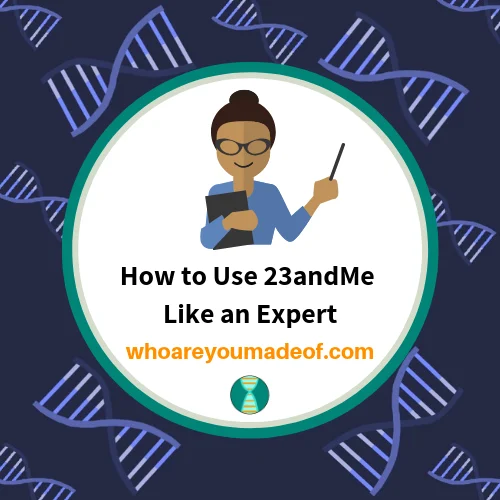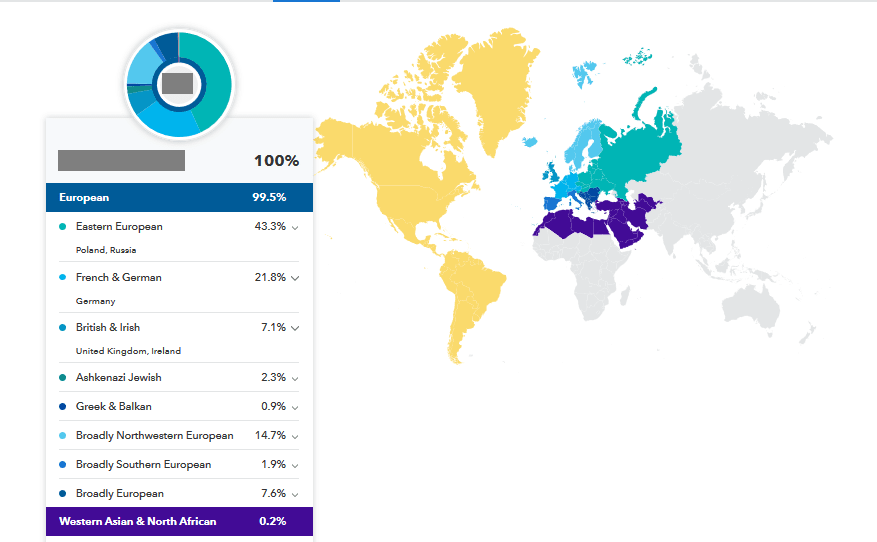Did you do your DNA test with 23andMe? If so, I want to make sure that you are getting the most from your DNA results. This post will teach you some of the coolest things that you can do with your results so you can use 23andMe like an expert.
I'm super-passionate about the incredible wealth of information that we can learn from our DNA results. Your 23andMe results are so much more than just your basic ancestry composition report, and I hope that this post inspires you to learn as much as you can from them.

Don't stop at your Ancestry Composition report - go further
Many of you probably already know this, but I want to make sure to mention that the main screen in your Ancestry Composition results is not all you can learn. Most of us have strong matches to regions around the world, and we can click on these regions to see exactly which cities, counties and administrative districts most closely match our DNA.
For example, my mom has 43% Eastern European DNA. In smaller print under this main region, I can see that 23andMe has matches her to both Poland and Russia:

If I click on the region, I can see some small linked text that says, "View Report". If I click on this option, I'll go to a completely new screen that will allow me to learn which regions in Poland and Russia match my mom's DNA.
You might be surprised by what you learn. For example, I was surprised to see a very specific region in Russia that matches my mother's DNA. She has no known Russian ancestry, though I assumed that based on proximity to Russia, it is conceivable that she may have had Russian ancestors very far back in her tree.
What does her match to this Russian region mean? It's a fascinating mystery to explore.
What will you find? Will it help confirm suspicions that you have about where your ancestors came from? What will it help you learn about your family's history?
Explore your 23andMe DNA match list in-depth (DNA Relatives)
Most people take a quick glance at their DNA match list on 23andMe, and rarely (if ever) check back. This makes me SO sad! There is a lot to learn from this match list.
I understand that the 23andMe DNA relatives list can be hard to understand. 23andMe reports our shared DNA in percentages and estimated relationships, and people don't usually include much information about their ancestors. How are these people related to us?
Use percentage of shared DNA to figure out how closely you might be related to your match
Most of our DNA matches won't have a very high percentage of shared DNA with us. You might be surprised to know that we only share 50% of our DNA with our parents, and as low as about 33% with a full sibling. A half-aunt or uncle (a half-sibling of one of our parents) can share as little as 7% of their DNA with us. A second cousin might share only 2% (or even less).
I like to use the DNA Painter shared cM (and %) tool to help me figure out which relationships are possible: Shared cM Project Tool. You can click the "show%" link under the box to enter in the percentage of shared DNA that you have with your match to receive likely relationship options.
Sort, filter, and examine your 23andMe relatives
There are lots of different ways to sort your DNA matches on 23andMe. I recommend taking advantage of the main search tool. You can search for a particular surname (or even filter said surname to only show matches that have that name), filter by country of ancestry, or sort matches to show the newest ones first.
There are many more ways to view your DNA relatives list. Check them all out. Also don't forget to contact your DNA match to see if they are willing to share family tree information with you. It can save a lot of time and guesswork 🙂
You might also be interested in my post, "How is your DNA match related? a checklist", which gives ideas about how to figure out how your match is connected with you.
Use segment data to verify and further explore your family tree
There are two ways that the segment data available from 23andMe can help you learn about your ancestors:
- The 23andMe chromosome browser
- Downloading your raw 23andMe data to view by segments (and their corresponding ancestry composition region). This is also referred to as downloading ethnicity data by segment.
Check out of the 23andMe chromosome browser
If you've spent some time exploring your DNA matches, you may have happened upon one of the most useful tools available in your 23andMe results. It's called a "chromosome browser".
Every human has 22 numbered (non-sex) chromosomes, and we share DNA segments on these chromosomes with people who are genetically related to us. We share more (or larger) segments on more chromosomes with closer relatives and smaller, less numerous segments on as few as only one chromosome with our distant relatives.
The 23andMe chromosome browser allows us to view the actual location of DNA segments that we share with our DNA matches. Knowing the exact location of a shared DNA segment can help us understand who our common ancestors are, and which lines of the family we are likely connected through.
I recommend using a cool website called "DNA Painter" to help you keep track of and learn about segment data available from your DNA matches.
Download your raw 23andMe data to view by segment (ethnicity data by segment)
One of the most little known things that you can do with your 23andMe results is to actually download your raw segment data to see which DNA segments match which ancestry composition region.
For example, if you have 2% Native American DNA, you could download your raw segment data to view exactly which DNA segments were identified as Native American.
Once you know which segment(s) are Native American, you could identify which DNA matches also match you at the same position on your chromosomes. With good research, you would be able to identify which ancestor likely contributed your Native American DNA segments. The next step would be to focus more research efforts on the ancestor that you identified to trace their indigenous roots.
The data is downloaded in a spreadsheet-type format. In following with our example, my mom has a small Native American DNA segment, which shows up like this on the downloaded data:

Highlighted in red, you can see that my mother has a small DNA segment on her Copy 2 of chromosome 8 that has been identified to possibly have Native American origin. If I have already mapped out my mom's chromosomes (using segment data from DNA matches), I could identify which line of her family likely passed this segment down to her.
This is the same basic process that you would use for any ancestry region that appeared in your results that you want to learn more about. The data that you can access is most easily managed using DNA Painter, too.
It's not an easy task to accomplish, but I am still amazed that all of this information is available to use through our simple saliva test from 23andMe.
Understand your 23andMe Y-DNA and mtDNA results
Most people think that Y-DNA and mtDNA results are just interesting and are not useful for learning about their family tree or ancestral origins. You might wonder how knowing where your maternal line ancestor lived 10,000 years ago could possibly help you.
Before I tell you how it can help you learn about your family tree (in limited circumstances, true), let's make sure we all understand exactly what our mtDNA and Y-DNA results are:
- mtDNA is passed down from mother to children, so your mtDNA results tell you about your mother's mother's mother's mother's (and so on, etc) direct line. Both males and females inherit mtDNA.
- Y-DNA is passed down from father to son. This means that your 23andMe Y-DNA results will tell you about your father's father's father's (and so on) line going back thousands of years. It's important to note that only males have a Y-DNA haplogroup because females do not carry Y-DNA.
Your Y-DNA and mtDNA results (i.e. your assigned haplogroup) should match relatives who share the same maternal or paternal line with you.
For example, my mom has a sister who has daughters (my first cousins). One of the daughters has a daughter of her own (first cousin once-removed to me). Since my first cousin once-removed shares her direct maternal line (back to my grandmother) with me, we should share the same mtDNA haplogroup.
mtDNA and Y-DNA are most commonly used to verify, along with other evidence (i.e. autosomal DNA and traditional genealogy) to "prove" that people are descended from a common paternal or maternal ancestor.
So, check out your mtDNA and Y-DNA (if you are a guy!) results and see what you can learn.
Conclusion
I hope that this post has helped give you some ideas about using 23andMe like an expert-level user. If you have any questions about something that you read in this post, or if you would like to share your own tips for using 23andMe, I would love to hear from you in the discussion below.
Thanks for stopping by today!

